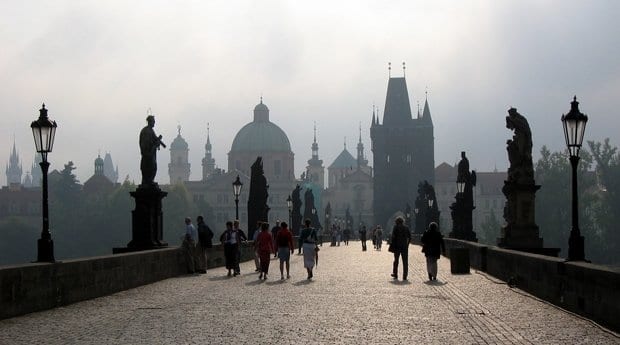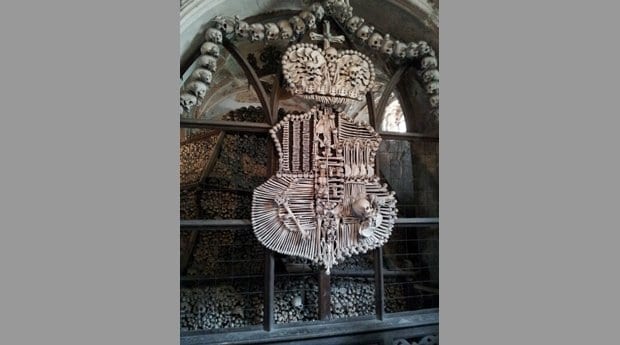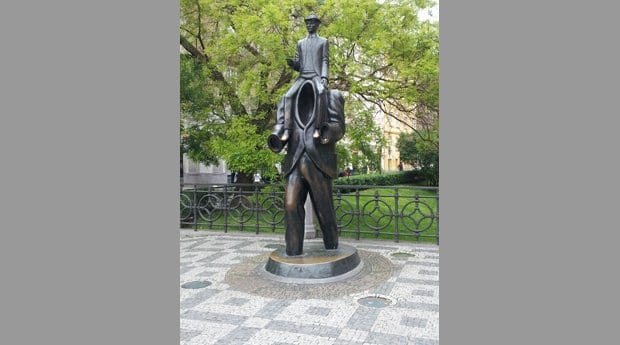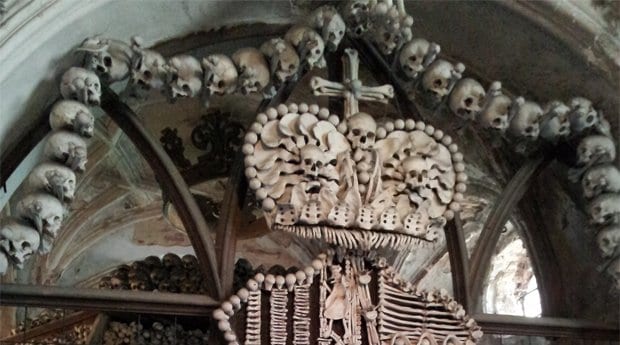
Kafka fans can visit the Franz Kafka Museum, just north of the Charles Bridge, a sight in itself. Credit: Chosovi

A full view of the gruesome coat of arms in the Sedlec Ossuary. Credit: Christian Baines

A bronze statue shows a suited Kafka sitting atop the shoulders of a headless giant, a reference to his short story “Description of a Struggle.” Credit: Christian Baines
Contrary to what the late lyricist Jonathan Larson wrote, Bohemia is not a fantasy in your head. You’d be forgiven, however, for thinking it’s a forest of tour groups. Peering through them to admire the statues lining the Charles Bridge or lifting your camera above dozens of others for that perfect shot inside St Vitus Cathedral have become an inevitable part of the Prague experience.
If today’s Prague feels more like a medieval Disneyland than a city, that’s all the more reason to find its quirky side. While the green absinthe fairy may not fly as free as she once did, Franz Kafka’s hometown is still a gothic treasure chest of splendid weirdness.
The tourist-heavy sights of the Castle and Jewish Quarters should not be missed, no matter how much you hate crowds. Prague Castle is a massive complex that — once you get past the swarm inside the Cathedral — offers plenty of space to stand back and let it all sink in.
Two of Prague’s oddball treats, however, can be found toward Petrin Hill. At the Museum of Miniatures, you’ll find masterpieces by da Vinci, Dalí and others, all shrunk down for perfect viewing under a microscope. Then cross the street to the Strahov Monastery. Besides its vast libraries and jaw-dropping interiors, the monastery’s Cabinet of Curiosities draws tourists eager to get a glimpse of its natural science collection, especially its star attraction: a grotesquely preserved dodo.
Kafka fans will want to find their way to Golden Lane, a tiny street inside the castle grounds that once housed its goldsmiths. There’s more here for souvenir hunters than history buffs, but number 22 is the former home of Ottla, Kafka’s favourite sister, with whom he lived from 1916 to 1917. The remainder of Golden Lane is a mix of overpriced tourist shops and kitschy medieval throwbacks, but what it lacks in authenticity, it makes up for in fun. Back on Kafka’s trail, fans can visit the Franz Kafka Museum, just north of the Charles Bridge. Local walking tours cover everything from the house in which the writer was born (Minute House, now part of the Town Hall) to his grave in the New Jewish Cemetery.
The old cemetery that forms part of the city’s popular Jewish Museum is a quirky treat in its own right, but there’s one last Kafka monument in the Jewish Quarter that deserves your attention. A bronze statue shows a suited Kafka sitting atop the shoulders of a headless giant, a reference to his short story “Description of a Struggle.” You’ll find it just outside the Spanish Synagogue, another highlight of the quarter, where Jewish and Moorish designs contrast to create one of the most unusual and beautiful small synagogues in Europe.
Prague’s most fascinating chamber of Cold War kitsch is the Museum of Communism. The ramshackle tone might remind some of Berlin’s DDR Museum. Even its location — above a McDonalds, next to a casino — is quirky, bordering on sarcastic. The display, however, makes a decent attempt at exploring the Czech Republic’s difficult years under Communism. You’ll find an authentic range of oddball artifacts and all the Soviet propaganda your poor eyes can stand. Watch footage of the 1989 revolution, and be sure to step outside for a small but moving display dedicated to North Korea. While the museum’s curation could use some work, it’s difficult not to leave at least a little moved, even as you pick up your obligatory and possibly homoerotic piece of souvenir Communist tat.
By far the most offbeat attraction luring visitors to Prague isn’t found in Prague at all, but an hour’s train ride away in Kutná Hora. This picture-perfect town on a hill was once known for its silver mining and the spectacular St Barbara’s Cathedral. Its biggest tourist draw, though, is the gruesome Sedlec Ossuary. The grinning spectre on a thousand BuzzFeed lists, the ossuary occupies a tiny church in the suburbs of Kutná Hora. Within its walls, the skeletal remains of 40,000 plague victims form coats of arms, ornate decorations and a chandelier said to contain every bone in the human body. The best-value ticket includes both Sedlec Ossuary and St Barbara’s Cathedral in town. Skip the uninspiring Cathedral of Our Lady; your time is better spent wandering Kutná Hora’s streets or taking a tour of the long abandoned silver mine.
Even as Prague bursts at the seams with tourists, it remains Bohemia’s beating heart. Oddity and curiosity are part of the city’s makeup, with plenty to pique your imagination after you’ve elbowed your way through to those perfect cathedral photos.
For the most up-to-date travel information on gay Prague, see our City Guide, Listings Guide, Events Guide and Activities Guide.

 Why you can trust Xtra
Why you can trust Xtra